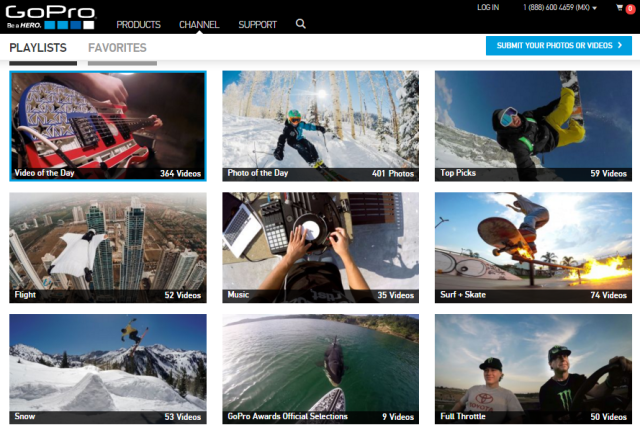

GoPro action cameras have enjoyed a rapid rise in popularity in the last few years. A cursory YouTube search reveals that they are ideal for everything from filming extreme sports to strapping to your dog’s head.
Despite their popularity, there is a lot of stuff your probably didn’t know about the devices. Here we look to shed some new light on the outdoor adventurer’s best friend:
News of GoPro’s ability to shoot in 3D might not have been picked up by amateur and infrequent users.
All you need are two Hero3+ cameras and the specially-designed tandem housing case. Once you’ve recorded the footage you can combine the two outputs into a 3D format by using the free GoPro Studio editing software.
The housing case costs $199.
Let’s face it – very few GoPro owners are actually throwing themselves out of airplanes or participating in extreme SCUBA diving – most are recording treasured times with the family, embarrassing moments at friends’ weddings, or pets doing stupid things. Similarly, very few users will be really good at using complex video editing software. These two issues combined can lead to amateur-looking videos.
That’s why it is a good idea to download the GoPro Studio.
It’s specially designed for use with your GoPro camera and offers a number of features that have been tailored to work specifically with your device.
For example – you can play back and export your time-lapse photo sequences as videos, you can use the “GoPro Edit Templates” to quickly produce a professional looking film, you can trim, edit, and mix video clips, and you can add titles, music, and other audio.
Finally, you can also share directly from the software to the GoPro Channel.
Unlike some company-operated video channels, the GoPro Channel is more than a mere advertising outlet. Instead, it features some of the most enjoyable and engaging user-generated action footage anywhere on the Web.

It’s available on virtually every media point that you’ll have in your house, including Roku, the PlayStation 3 and 4, the Xbox One, smart TVs, the Apple TV, YouTube, and the company’s own website.
The videos are categorized into individual sections such as “Flight,” “Snow,” “Burning Rubber,” and “Wild Animals,” and there is also a video of the day and a photo of the day.
Whether you think that video-capturing drones are an incredible invention or an annoying invasion of privacy, there is little denying that they are set to become one of the fastest-selling tech gadgets in 2016. Entry into this sector is the obvious next step for GoPro.
News about the upcoming “GoPro Karma” broke towards the end of last year, with initial reports suggesting that it’ll boast a video resolution of at least 8K along with a high-quality gimbal that’ll remove the need for post-production video stabilization.
Early estimates predict it will cost between $500 and $1,000.
The company presumably hope these new drones will help to arrest its declining sales. GoPro released disappointing financial results for Q4 2015, and shares that were once worth $94 are now only valued at $11-12.
Who needs a marketing budget when you can just get someone to accidentally drop their camera from 3,800 meters (12,500 feet)?!
That’s what happened back in 2012, when a skydiver hit his head on the roof of the plane as he jumped out, dislodging the camera from its holder in the process.
The camera was in freefall for seven minutes, but landed unscratched and unscathed in a field below. It even caught the owner’s landing! Apparently, a similar thing happened to the owner’s friend who was using a regular SLR camera – unsurprisingly, the result was somewhat less satisfactory.
The company’s founder, Nick Woodman, is an avid surfer. He found that the amateur photographers he used to work with couldn’t get close enough to the action while he was in the water, so he wanted a way to shoot professional-looking camera angles – hence the name.
Woodman started to raise the capital for his venture by selling shells and beads out of the back of his VW van while touring around Australia and Indonesia in his early 20s.
He originally went on the trip in an attempt to inspire himself to start a company, but has since revealed he actually had the GoPro idea before he even left.
As the video above shows, Woodman told CNBC, “The irony was this trip was meant to inspire me for my next business, but I had my business idea before I even left”.
The combination of a high frame rate and its position as the market leader in point-of-view action cameras has seen GoPro’s devices become one of the must-have gadgets on the sets of Hollywood filmmakers.
In the last couple of years alone they’ve been used in Need for Speed, Captain Phillips, and Gravity. No doubt there are lots more examples.
If it’s good enough for Tom Hanks, it’s good enough for us, right?
Do you have any tips or facts about your GoPro camera that you can share with your fellow readers?
Perhaps you have discovered a cool new way to record video, or you know about a neat trick that will unlock some hidden potential? Let us know all about it in the comments section below.




 Xenoblade Chronicles Beginner’s Walkthrough
Xenoblade Chronicles Beginner’s Walkthrough How to Get Ohm, Fully automatic Heavy Weapon in Call of Duty: Advanced Warfare Ascendance
How to Get Ohm, Fully automatic Heavy Weapon in Call of Duty: Advanced Warfare Ascendance Valiant Hearts: The Great War Complete Video Walkthrough for All Chapters
Valiant Hearts: The Great War Complete Video Walkthrough for All Chapters Vehicles in Grand Theft Auto V, Guide and Walkthrough for GTA 5
Vehicles in Grand Theft Auto V, Guide and Walkthrough for GTA 5 Are More People Browsing The Web On Desktop or Mobile?
Are More People Browsing The Web On Desktop or Mobile?